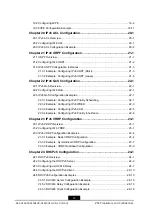
ZXR10 ZSR V2 Configuration Guide (IPv6)
IPv4 and IPv6 Header Format
The following are differences between IPv4 and IPv6 in header format.
The header formats of IPv4 and IPv6 as shown in
and
respectively.
(Numbers in the figures refer to bit numbers.)
Figure 2-1 IPv4 Header Format
Figure 2-2 IPv6 Header Format
IPv6 header is simpler than IPv4 header in structure because many fields in IPv4 header
that are not frequently used are deleted from IPv6 header, and are put into its options and
header extension, which are defined more strictly.
l
IPv4 contains ten fields with fixed length, two address spaces and some options, while
IPv6 contains only six fields and two address spaces.
l
Although IPv6 header occupies 40 bytes, which is 1.6 times of IPv4 header with
24-bytes, it does not consume too much memory capacity due to its fixed length (the
length of the IPv4 header is variable).
l
The following six fields are deleted from IPv4 header: header length, type of service,
identifier, flags, fragmented offsets and header checksum. Names and some functions
of the three fields of total length, protocol and Time to Live (
) are changed, and
its optional functions are completely changed. Apart from this, two fields are added:
traffic type and flow label.
l
IPv6 header format is greatly simplified, which effectively pares down overhead of
processing headers by a router or switch. At the same time, IPv6 enhances the
2-2
SJ-20140504150128-018|2014-05-10 (R1.0)
ZTE Proprietary and Confidential
Содержание ZXR10 ZSR
Страница 12: ...This page intentionally left blank IV SJ 20140504150128 018 2014 05 10 R1 0 ZTE Proprietary and Confidential ...
Страница 306: ...Figures This page intentionally left blank IV SJ 20140504150128 018 2014 05 10 R1 0 ZTE Proprietary and Confidential ...
Страница 308: ...This page intentionally left blank VI SJ 20140504150128 018 2014 05 10 R1 0 ZTE Proprietary and Confidential ...
















































